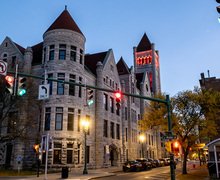Syracuse’s past time
A phone call broke the news to Andy Mogish in February 1972 during an early team workout. There were rumblings the Syracuse baseball team would not survive the recession, but the team didn’t expect the program’s removal so close to opening day.
Mogish, Syracuse’s last baseball coach, brought his team together and told them what happened. They all knew the rumors, but it was only gossip until that moment. Some players came to Syracuse for a baseball program that was snatched up from underneath them in the middle of their careers.
Weeks before the season, the Athletic Policy Board, a committee of university administrators, concluded America’s pastime no longer fit in Syracuse’s landscape. Officially, the program was only suspended, not discontinued, but there has been no NCAA baseball at Syracuse since.
No one on the team understood why the decision was made, Mogish said. Trying to calm everyone down, Mogish promised he would keep the program running as a club team. He would schedule games and the team would continue despite the Athletic Policy Board’s decision.
Mogish started working, confident everything would eventually work out. A few days later, Mogish asked the team manager to prepare the equipment for future practices.
‘We don’t have any more,’ the manager said, Mogish recalled.
Without telling anyone in the program, the assistant athletic director sold all the baseball equipment and uniforms, marking the end of a 99-year era at Syracuse.
‘That was a low blow,’ Mogish sighed, his voice cracking. ‘We never had a chance – Oh God! – that really was a low blow.’
***
Money was the deciding factor in baseball’s demise at Syracuse. According to the minutes from the 1972 Athletic Policy Board meetings, a recession was sweeping through the university. Cutting several non-revenue sports was a potential solution, especially with the phenomenon of Title IX beginning to pervade college athletic departments.
Title IX is still a major reason why baseball has not resurfaced. Baseball – the first intercollegiate athletic program established at SU – had considerable costs and made little money for the school. Although Syracuse has considered new non-revenue programs, baseball is not a top priority.
Other obstacles that faced the baseball program 40 years ago prevent the sport’s reinstatement today. Once one of the most popular sports on campus, baseball and Syracuse was always a difficult partnership.
Like baseball squads at most Northeast schools, the team played few home games each season and lost some of its schedule to inclement weather. While teams in better climates could practice outside for most of the year, Syracuse was forced indoors until its first game of an annual Southern trip.
‘It was extremely difficult,’ former Syracuse outfielder Doug Clemens said. ‘We’d be working out in a barn in sweats and a hooded jacket, then we’d go out and run in the snow. It was really brutal because in my era we didn’t even have the Field House yet, let alone a great big dome.’
A curtailed academic calendar did not help. Classes at Syracuse once continued until the end of May or even the beginning of June. In 1973 the spring semester ended on April 27, which would require additional expenses to keep the baseball team around to play a legitimate baseball schedule. Current conference and NCAA tournaments run through June.
The Athletic Policy Board could not justify keeping the baseball program if the major postseason events were almost two months after the end of school, especially because Syracuse was not a consistent contender.
‘When they changed the academic calendar that year, it was the biggest problem we had,’ Mogish, now 87 years old, said by phone. ‘We could always work around the snow and the weather and other problems by playing a full slate of games in May, but we really couldn’t do that anymore.’
***
Recruiting in Syracuse was always a major issue, especially because the program only had one and a half scholarships each year. Baseball grants were eventually eliminated altogether. Some players, including those who went on to play in the Major Leagues, had scholarships for other sports.
‘Baseball was just another sport for those guys,’ said Gary Rainbow, who played baseball for Syracuse in the late ’60s and early ’70s. ‘Baseball really became just a training option in the spring – a way to stay in shape after spring football.’
Because ballplayers in northern cities like Syracuse can only play outdoors for a few months each year, the common belief is that there is not much talent in the area. Professional and big Division-I recruiters traditionally do not scout the Northeast as much as the South and the West.
Kevin Rockwell, head baseball coach at Cicero-North Syracuse High School, said the area is generating more attention. C-NS is one of the area’s most successful baseball teams, going 100-42 since 2001. In the last two years, five NorthStars’ players signed on with D-I programs.
Scouts may not frequent this part of the country, but Rockwell said there are no secrets anymore. Central New York prospects play ball all summer and fall, sometimes on three or four different teams. Close to 100 scouts attend the annual Empire State Games.
‘The colleges will make sure they see you if you have talent,’ Rockwell said. ‘If a kid can play, it doesn’t matter where he lives.’
Nor is it impossible to maintain a college baseball program in cold weather. Syracuse, Marquette University, DePaul University and Providence College are the only Big East schools not to field a baseball team. Most of the Big East schools are in the Northeast.
Le Moyne College, just a few miles from the SU campus, qualified for the College World Series in 2003 and 2004. From 2002-06, the Dolphins went 100-29.
On its current roster, 23 of 30 players are from New York and Canada. Head coach Steve Owens said Le Moyne always tries to recruit the Central New York area first, but four Le Moyne players are from Florida.
‘There are only so many kids from down there that could play at Miami, Florida State and Florida International,’ Owens said. ‘A kid may not want to ride the bench for three years at Florida State before seeing the field. He could come here and make an impact right away.’
***
Syracuse played its home games on Lew Carr Field, named after the Orangemen’s coach from 1910-1942. The field was situated behind Manley Field House, where the lacrosse practice fields are today. At the height of the sport’s popularity, often more than 1,000 fans attended the games.
But crowds shrunk as the field deteriorated and basketball grew.
‘We sometimes had as many as 20 people at our games,’ Clemens said. ‘If you didn’t count our dads and girlfriends, you could probably count them on your hands.’
Until the weather improved, the team practiced in an old barn adjacent to Manley. There was a batting cage made of nets and some artificial mounds for pitchers to throw batting practice, but not much else. The only heating was a big space heater inside. There was no way to work on fielding or baserunning, nor could the pitchers realistically throw live pitches to batters.
‘It was freezing, inside and out,’ Clemens said. ‘All the stinging and jamming in the cold environment. Balls would be bouncing off the walls and ceiling so you had to protect yourself at all times.’
The southern trip every year helped, but Syracuse was always at a disadvantage. Its opponents would already have played a few weeks worth of games. When Syracuse’s pitchers would make their first start of the season, teams like Georgetown and George Washington would be at least two turns through their rotations.
‘We really didn’t have any other options,’ said Dave Giusti, a pitcher for Syracuse who went on to play 15 years in Major League Baseball for five different teams. ‘It was always a highlight because we finally got the chance to play on grass, but it really wasn’t easy for us. That’s just what we had to go through.’
***
Baseball is not coming back to Syracuse, at least in the foreseeable future. A club team was established in 1979 and has been successful in tournaments. But senior Kyle Lennon, the team’s coach, said they are not looking to make baseball a varsity sport again.
Even if the club team tried, the odds are stacked against it. In a Sept. 12, 2006, story that appeared in The Daily Orange, Michael Wasylenko, current chairman of the Athletic Policy Board, said Title IX and Syracuse’s athletic budget is still a major crutch.
‘If we added a men’s sport, we’d have to get rid of a men’s sport,’ Wasylenko said in the article. ‘And that’s probably not a good idea.’
But the face of college baseball in the Northeast may be changing. Starting next season, the last weekend of February is the earliest teams can schedule their first games. Previously, schools could start playing whenever the weather warmed up.
When Le Moyne takes its southern trip, like Syracuse once did, its opponents will also be playing its first games. Both team’s pitchers will be making their first starts of the year.
The new rule probably will not change recruiting – the best prospects will continue to flock down south – but should help Northeast schools win early-season games crucial for at-large bids to the postseason. There may not be a major power shift right away, but the new rule makes baseball a viable option for more cold-weather schools, Owens said.
So even though baseball at SU is far from imminent, it may not be impossible.
‘Without question, you could be successful in this part of the country,’ Owens said. ‘I know money is a big issue at a lot of places, but just talking about the game itself, I see no reason why baseball couldn’t be a great fit at Syracuse.’
Published on April 5, 2007 at 12:00 pm





